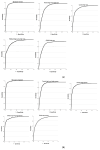Usefulness of the Córdoba Equation for Estimating Body Fat When Determining the Level of Risk of Developing Diabetes Type 2 or Prediabetes
- PMID: 40282904
- PMCID: PMC12028798
- DOI: 10.3390/medicina61040613
Usefulness of the Córdoba Equation for Estimating Body Fat When Determining the Level of Risk of Developing Diabetes Type 2 or Prediabetes
Abstract
Background and Objectives: Type 2 diabetes (T2D) and prediabetes represent major global health concerns, with obesity being a key risk factor. However, recent evidence suggests that the adipose tissue composition and distribution play a more critical role in metabolic dysfunction than the total body weight or body mass index (BMI). This study evaluates the predictive capacity of the Córdoba Equation for Estimating Body Fat (ECORE-BF) for identifying individuals at high risk of developing T2D and prediabetes. Materials and Methods: A cross-sectional study was carried out involving 418,343 Spanish workers. Body fat percentage was estimated using the ECORE-BF equation, and diabetes risk was assessed using validated predictive models, including the Finnish Diabetes Risk Score (FINDRISC), QDiabetes score (QD-score), and others. The discriminatory power of ECORE-BF in predicting T2D and prediabetes was assessed using receiver operating characteristic (ROC) curve analysis. Results: ECORE-BF showed a strong correlation with high-risk classifications across all diabetes risk scales. The area under the ROC curve (AUC) exceeded 0.95 for both men and women, demonstrating high predictive accuracy. Conclusions: Adipose tissue distribution, particularly visceral adiposity, is a central factor in metabolic dysfunction. ECORE-BF provides a cost-effective alternative for large-scale T2D and prediabetes risk assessment. Future research should explore the impact of visceral adipose tissue reduction on diabetes prevention and the integration of estimation scales into clinical and public health strategies.
Keywords: ECORE-BF; body composition; body fat; diabetes mellitus; prediabetes; visceral fat.
Conflict of interest statement
The authors declare no conflicts of interest.
Figures
Similar articles
-
A Comparison of Equation Córdoba for Estimation of Body Fat (ECORE-BF) with Other Prediction Equations.Int J Environ Res Public Health. 2020 Oct 29;17(21):7940. doi: 10.3390/ijerph17217940. Int J Environ Res Public Health. 2020. PMID: 33138089 Free PMC article.
-
Usefulness of the ECORE-BF Scale to Determine Atherogenic Risk in 386,924 Spanish Workers.Nutrients. 2024 Jul 26;16(15):2434. doi: 10.3390/nu16152434. Nutrients. 2024. PMID: 39125315 Free PMC article.
-
Body adiposity and type 2 diabetes: increased risk with a high body fat percentage even having a normal BMI.Obesity (Silver Spring). 2011 Jul;19(7):1439-44. doi: 10.1038/oby.2011.36. Epub 2011 Mar 10. Obesity (Silver Spring). 2011. PMID: 21394093
-
Visceral adiposity and inflammatory bowel disease.Int J Colorectal Dis. 2021 Nov;36(11):2305-2319. doi: 10.1007/s00384-021-03968-w. Epub 2021 Jun 9. Int J Colorectal Dis. 2021. PMID: 34104989 Review.
-
Current evidence on gender-related risk factors for type 1 diabetes, type 2 diabetes and prediabetes: a reappraisal of the Italian study group on gender difference in endocrine diseases.J Endocrinol Invest. 2025 Mar;48(3):573-585. doi: 10.1007/s40618-024-02491-3. Epub 2024 Nov 21. J Endocrinol Invest. 2025. PMID: 39570488 Review.
References
MeSH terms
LinkOut - more resources
Full Text Sources
Medical
Miscellaneous



